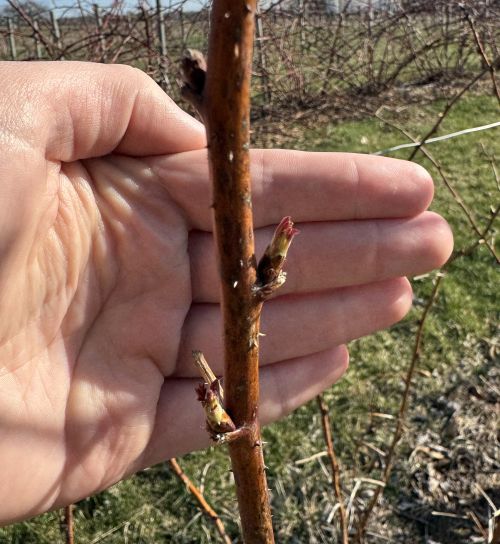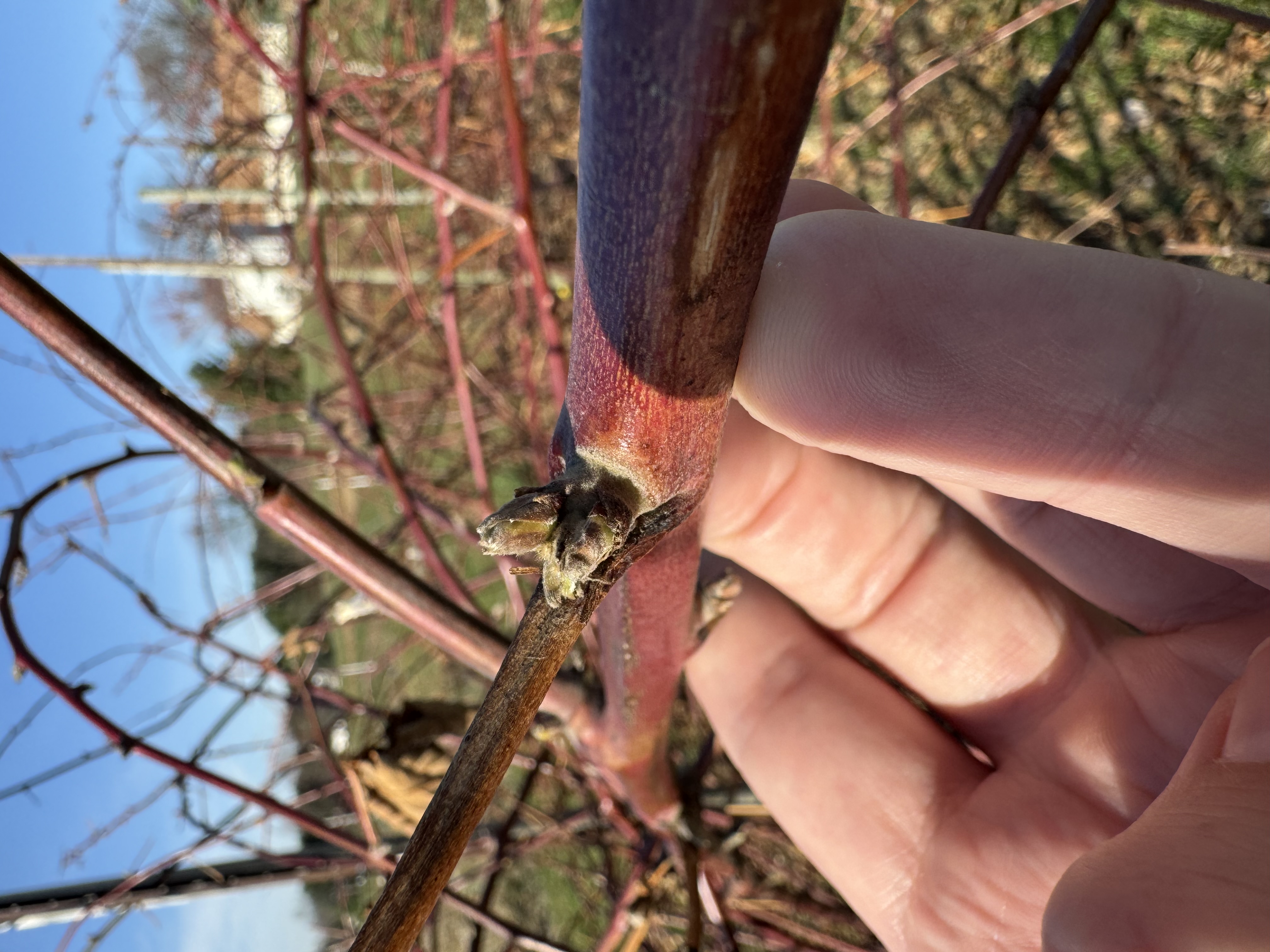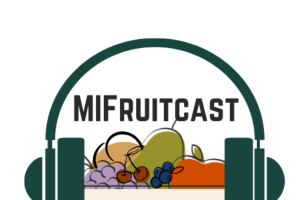Southeast Michigan fruit update - April 8, 2025
Apples are at green tip and blueberries are at bud swell.

Welcome to the first in-season fruit article update for southeast Michigan for the 2025 season. Throughout the season these updates will include information about the weather in the past week and the upcoming week, a fruit-by-fruit guide to current conditions with appropriate pest and disease updates, and other relevant observations.
General observations
We are still early in the season. We are starting to accumulate some growing degree days, but with cool temperatures expected in the next week bud progression will remain slow. The first traps of the season have gone out for a project on ambrosia beetles and the trapline at Trevor Nichols Research Center in Fennville, Michigan, has also started up. Additional monitoring will start towards the end of the month.
Many of you will have already done spring weed control, but if not, this 2020 Michigan State University Extension article on spring herbicide applications lists some available options.
This year, our weekly integrated pest management (IPM) updates will be separated into two meetings: a small fruit meeting for southern Michigan held on Tuesday evenings and a statewide tree fruit IPM update on Wednesdays at noon. It is a good opportunity to hear form experts, ask questions and receive restricted use pesticide (RUP) credits. See the latest weekly fruit meetings for southern Michigan on MSU’s Kaltura Media Space (these may take a few days to upload after the meetings are held).
Fruit-by-fruit conditions
Note: Many of these observations took place last week, but with the cool temperatures there has been little movement in bud development.
Apples
Green tip in McIntosh was set for March 31 in Romeo. This is used as the biofix for monitoring apple scab. At silver tip, the critical temperatures are 15 degrees Fahrenheit for 10% kill and 2 F for 90% kill. At green tip, the critical temperatures are 18 F for 10% kill and 10 F for 90% kill. At half-inch green, the critical temperatures are 23 F for 10% kill and 15 F for 90% kill.
Blueberries
We are at bud swell in blueberry plantings in Fenton. This is the primary risk period for mummy berry and it is time to start paying attention to phomopsis. FRAC 3 fungicides are reported to be efficacious for both mummy berry and phomopsis. At bud swell we see damage when temperatures drop to the 10-15 F range.
Brambles
We are seeing some bud swell in raspberries and blackeberries.

Cherries
We are seeing swollen bud stage in sweet and tart cherries. At swollen bud the critical temperatures for tart cherries are 15 F for 10% kill and 0 F for 90% kill. At swollen bud the critical temperatures for sweet cherries are 17 F for 10% kill and 5 F for 90% kill.
Grapes
Some growers are still pruning grapes. I haven't seen first swell in the region, but it has been seen in southwest Michigan. At first swell the critical temperatures are 13 F for 10% kill and -3 F for 90% kill.
Strawberries
We are seeing some greening in field strawberries in Fenton, but no signs of crown formation yet. Early season fungicides should focus on controlling leaf spot.
Peaches and nectarines
Peaches in Fenton are at the swollen bud stage. At swollen bud the critical temperatures are 18 F for 10% kill and 1 F for 90% kill.
Pears
Pears observed in Fenton were at bud scale separation. At bud scale separation the critical temperatures are 15 F for 10% kill and 0 F for 90% kill. When blossom buds are exposed the critical temperatures are 20 F for 10% kill and 6 F for 90% kill.
Plums
European plums in Fenton were observed at first swell. At first swell the critical temperatures are 14 F for 10% kill and 0 F for 90% kill. Prune out black knot and dispose of the knots by burning or removing from the orchard. Sanitation is an important step in managing this disease.
Insect conditions
More in-depth information can be found by watching the latest weekly fruit meetings on MSU’s Kaltura Media Space (these may take a few days to upload after the meetings).
Black stem borer: Females start to search for new sites to deposit eggs around 100 GDD50. The main control is to target emerging females at that point. Our warmest regions are forecast to get to 100 GDD50 next week.
European red mite: Control for European red mite usually begins at tight cluster in apples and should be completed before the pink stage.
Green fruit worm: First catches have been reported in Fennville. These can be controlled with insecticides post-bloom.
Oriental fruit moth: Most of the region is in the egg-deposition control point where you can use of ovicidal products from 100-150 GDD45.
Pear psylla: Egg hatch will be climbing quickly in about a week
Rosy apple aphid: Egg hatch is usually complete around the half-inch green stage and control is best applied around tight cluster.
San Jose scale: A delayed dormant oil spray between green tip and pink can be used to control scale. After this period the next time to control is when crawlers emerge in early summer.
Spotted tentiform leafminer: Control for spotted tentiform leafminer is usually not necessary, but may be useful in problem areas beginning at tight cluster in apples
Disease conditions
Apple scab: While a biofix has been set, we are not expecting scab risk for the next week. Early control of scab is important for reducing secondary scab infections that can affect fruit.
Black knot: There is still time to prune out and burn black knot in plums and sour cherries. Fungicides may be used for limited control to supplement pruning and sanitation efforts.
Brown rot: This disease affects stone fruit and can proliferate during bloom, but we have not reached bloom yet. Fungicides may be necessary to control if bloom is during a warm period, especially in orchards that have had brown rot presence in previous seasons.
Cherry leaf spot: We are not expecting cherry leaf spot risk in the next week. See this 2013 article on cherry leaf spot management.
Grape black rot: Control for grape black rot usually begins at 1” shoot length, but we have yet to see grapes past first swell in the region. See this 2014 article for grape black rot management options and consult E-154.
Mummy berry: We are in the primary season for mummy berry infections. See the linked document E2846 for control methods.
Phomopsis: In blueberries the Phomopsis fungus is active from bud swell until after harvest.
Powdery mildew of apple and pear: You can start to include products labeled for powdery mildew in sprays starting at tight cluster.
Seasonal weather update
In the last week, southeast Michigan has seen on average of over 20 hours of rain accumulating to nearly 2 inches of precipitation. We are ahead of the five-year average in both time and amount of rainfall.
| Liquid Precipitation Accumulation Mar. 1- Apr. 6, 2025, issued Apr. 7, 2025 | ||||
|---|---|---|---|---|
| Station (County) | Rainfall Total (in.) Current | Hours with Rainfall Current | Rainfall Total Average (5 Yr.) | Hours with Rainfall Average (5 Yr.) |
| Commerce (Oakland) | 4.1 | 90 | 3.3 | 71 |
| Deerfield (Monroe) | 4.4 | 85 | 3.2 | 69 |
| East Lansing MSU Hort (Ingham) | 4.8 | 88 | 3.8 | 74 |
| Emmett (St. Clair) | 4.2 | 76 | 3.3 | 68 |
| Flint (Genesee) | 4.8 | 86 | 3.8 | 74 |
| Freeland (Saginaw) | 3.8 | 81 | . | . |
| Hudson (Lenawee) | 5.4 | 93 | 3.8 | 74 |
| Ithaca (Gratiot) | 4.5 | 85 | 3.8 | 78 |
| Lapeer (Lapeer) | 4.3 | 85 | 3.0 | 68 |
| Linwood (Bay) | 3.4 | 81 | 3.5 | 72 |
| Pigeon (Huron) | 3.1 | 100 | 2.9 | 68 |
| Richville/Frankenmuth (Tuscola) | 5.6 | 86 | 3.6 | 71 |
| Romeo (Macomb) | 4.0 | 84 | 3.2 | 67 |
| Sandusky (Sanilac) | 4.2 | 70 | 3.1 | 63 |
| Average of stations in this region: | 4.3 | 85.0 | 3.4 | 70.5 |
| Difference in Liquid Precipitation Accumulation from Mar. 1 observed Mar. 31 and Apr. 6, 2025; issued April. 7, 2025 | ||||||
|---|---|---|---|---|---|---|
| Rainfall Total (in.) | Rainfall Total (in.) | Hours with Rainfall | Hours with Rainfall | |||
| Station (County) | 31-Mar | 6-Apr | Difference | 31-Mar | 6-Apr | Difference |
| Commerce (Oakland) | 2.5 | 4.1 | 1.6 | 72 | 90 | 18.0 |
| Deerfield (Monroe) | 2.5 | 4.4 | 1.9 | 66 | 85 | 19.0 |
| East Lansing MSU Hort (Ingham) | 3.1 | 4.8 | 1.7 | 65 | 88 | 23.0 |
| Emmett (St. Clair) | 2.2 | 4.2 | 2.0 | 53 | 76 | 23.0 |
| Flint (Genesee) | 2.5 | 4.8 | 2.3 | 62 | 86 | 24.0 |
| Freeland (Saginaw) | 2.4 | 3.8 | 1.4 | 61 | 81 | 20.0 |
| Hudson (Lenawee) | 3.3 | 5.4 | 2.0 | 72 | 93 | 21.0 |
| Ithaca (Gratiot) | 2.6 | 4.5 | 1.9 | 60 | 85 | 25.0 |
| Lapeer (Lapeer) | 2.4 | 4.3 | 1.9 | 66 | 85 | 19.0 |
| Linwood (Bay) | 2.3 | 3.4 | 1.2 | 65 | 81 | 16.0 |
| Pigeon (Huron) | 2.2 | 3.1 | 0.9 | 70 | 100 | 30.0 |
| Richville/Frankenmuth (Tuscola) | 2.7 | 5.6 | 2.9 | 63 | 86 | 23.0 |
| Romeo (Macomb) | 2.0 | 4.0 | 2.0 | 64 | 84 | 20.0 |
| Sandusky (Sanilac) | 1.9 | 4.2 | 2.3 | 48 | 70 | 22.0 |
| Average of stations in this region: | 2.5 | 4.3 | 1.9 | 63.4 | 85.0 | 21.6 |
In the short term, we are expecting cloudy and cool conditions through Thursday, April 10, with conditions warming over the weekend. There is potential for rain early next week. Overnight lows for the next couple days will be in the 20s warming to the 30s over the weekend while highs will climb from the 30s during the week to the 50s and 60s over the weekend.
In the medium term, we are expecting both temperatures and precipitation totals to be near or slightly above normal. The long lead outlooks are calling for both temperature and precipitation to be near normal.
Our regional average growing degree day accumulation for the season are ahead of the five-year average by 34 GDD at 42 F, 39 GDD at 45 F, and 19 GDD at 50 F (see table below). This puts us at one to two weeks ahead of normal in most of the region, but at this early stage this may change. Read this Michigan State University Extension article to learn more about degree days: Understanding growing degree-days.
| Degree Day Accumulation Mar. 1-Apr. 6, 2025 Forecast from April 7-12, 2025; issued Apr. 7, 2025 | |||||||||
|---|---|---|---|---|---|---|---|---|---|
| Station (County) | Degree Days Base 42°F Current | Degree Days Base 42°F Average (5 Yr.) | Degree Days Base 42°F Forecast | Degree Days Base 45°F Current | Degree Days Base 45°F Average (5 Yr.) | Degree Days Base 45°F Forecast | Degree Days Base 50°F Current | Degree Days Base 50°F Average (5 Yr.) | Degree Days Base 50°F Forecast |
| Commerce (Oakland) | 165 | 122 | 179 | 126 | 87 | 133 | 73 | 47 | 77 |
| Deerfield (Monroe) | 207 | 165 | 225 | 158 | 122 | 168 | 96 | 69 | 100 |
| East Lansing MSU Hort (Ingham) | 187 | 137 | 201 | 142 | 99 | 151 | 83 | 55 | 87 |
| Emmett (St. Clair) | 135 | 104 | 144 | 98 | 73 | 103 | 53 | 37 | 55 |
| Flint (Genesee) | 188 | 136 | 200 | 144 | 99 | 152 | 87 | 55 | 91 |
| Freeland (Saginaw) | 114 | 100 | 126 | 80 | 70 | 88 | 42 | 38 | 45 |
| Hudson (Lenawee) | 186 | 143 | 201 | 142 | 105 | 151 | 85 | 60 | 89 |
| Ithaca (Gratiot) | 146 | 116 | 159 | 106 | 82 | 115 | 58 | 44 | 62 |
| Lapeer (Lapeer) | 174 | 129 | 183 | 132 | 93 | 138 | 79 | 51 | 81 |
| Linwood (Bay) | 94 | 83 | 106 | 67 | 58 | 75 | 36 | 32 | 39 |
| Pigeon (Huron) | 101 | 86 | 107 | 71 | 61 | 75 | 37 | 33 | 38 |
| Richville/Frankenmuth (Tuscola) | 144 | 116 | 155 | 105 | 83 | 113 | 58 | 43 | 61 |
| Romeo (Macomb) | 154 | 116 | 167 | 115 | 82 | 122 | 65 | 43 | 68 |
| Sandusky (Sanilac) | 134 | 97 | 141 | 98 | 68 | 102 | 52 | 36 | 53 |
| Average of stations in this region: | 152 | 118 | 164 | 113 | 84 | 120 | 65 | 46 | 68 |
| Difference in Degree Day Accumulation from Mar. 1, 2025 observed Mar. 31 and Apr. 6, 2025; issued April 7, 2025 | |||||||||
|---|---|---|---|---|---|---|---|---|---|
| Station (County) | Degree Days Base 42°F | Degree Days Base 42°F | Degree Days Base 42°F | Degree Days Base 45°F | Degree Days Base 45°F | Degree Days Base 45°F | Degree Days Base 50°F | Degree Days Base 50°F | Degree Days Base 50°F |
| Mar. 31 | Apr. 6 | Difference | Mar. 31 | Apr. 6 | Difference | Mar. 31 | Apr. 6 | Difference | |
| Commerce (Oakland) | 144 | 165 | 21.0 | 112 | 126 | 14.0 | 68 | 73 | 5.0 |
| Deerfield (Monroe) | 173 | 207 | 34.0 | 136 | 158 | 22.0 | 86 | 96 | 10.0 |
| East Lansing MSU Hort (Ingham) | 160 | 187 | 27.0 | 124 | 142 | 18.0 | 76 | 83 | 7.0 |
| Emmett (St. Clair) | 117 | 135 | 18.0 | 87 | 98 | 11.0 | 48 | 53 | 5.0 |
| Flint (Genesee) | 161 | 188 | 27.0 | 126 | 144 | 18.0 | 80 | 87 | 7.0 |
| Freeland (Saginaw) | 94 | 114 | 20.0 | 68 | 80 | 12.0 | 39 | 42 | 3.0 |
| Hudson (Lenawee) | 155 | 186 | 31.0 | 121 | 142 | 21.0 | 75 | 85 | 10.0 |
| Ithaca (Gratiot) | 122 | 146 | 24.0 | 91 | 106 | 15.0 | 53 | 58 | 5.0 |
| Lapeer (Lapeer) | 149 | 174 | 25.0 | 117 | 132 | 15.0 | 73 | 79 | 6.0 |
| Linwood (Bay) | 82 | 94 | 12.0 | 60 | 67 | 7.0 | 34 | 36 | 2.0 |
| Pigeon (Huron) | 84 | 101 | 17.0 | 61 | 71 | 10.0 | 33 | 37 | 4.0 |
| Richville/Frankenmuth (Tuscola) | 120 | 144 | 24.0 | 90 | 105 | 15.0 | 53 | 58 | 5.0 |
| Romeo (Macomb) | 132 | 154 | 22.0 | 100 | 115 | 15.0 | 59 | 65 | 6.0 |
| Sandusky (Sanilac) | 114 | 134 | 20.0 | 85 | 98 | 13.0 | 47 | 52 | 5.0 |
| Average of stations in this region: | 129 | 152 | 23 | 98 | 113 | 15 | 59 | 65 | 6 |
Watch Jeff Andresen's weekly agricultural weather forecast reports.
More information and reports on normal weather conditions and departures from normal can be found on the NOAA Climate Prediction Center website, NOAA U.S. Climate Normals website, NOAA Climate Normals Quick Access Page (which may be searched by region), and Midwest Regional Climate Center website.
This work is supported by the Crop Protection and Pest Management Program [grant no 2024-70006-43569] from the USDA National Institute of Food and Agriculture. Any opinions, findings, conclusions, or recommendations expressed in this publication are those of the author(s) and do not necessarily reflect the view of the U.S. Department of Agriculture.



 Print
Print Email
Email
